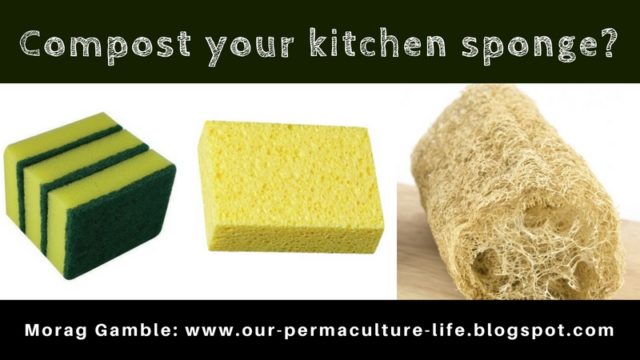It turns out they are neither good for our health or the planet. Firstly, they are a source of much waste. The sponges each household throws away in a year will take up landfill space for more than 52,000 years. Plastic based sponges cannot be recycled or composted.
Secondly, moist sponges are apparently the number one source of germs in your entire home – great places for salmonella, E.coli and staphylococcus – dirtier than your toilet or your bin. It’s not enough to just wash sponges, they need to be sanitised too – boiling, zapping or soaking in vinegar.
The other problem with sponges is that they are disposable and full of chemicals. Even after they have been thrown away, the bacteria-killing triclosan that they’re impregnated with negatively impacts aquatic ecosystems. Triclosan, an antimicrobial agent (and pesticide) that has been linked to cancer, developmental toxicity and skin irritation.
Magic sponges – not compostable and create microplastic waste
White magic sponges are made from melamine foam. Melamine foam is made from the compound formaldehyde-melamine–
Standard foam sponges – not compostable and emit toxins
Most sponges are now made from synthetic and petrochemcial materials. Polyurethane, often used in sponges, can emit formaldehyde. They are not compostable.
Standard cellulose sponges are compostable but usually contain chemicals.
The common kitchen sponge is made of cellulose fibre (eg: wood pulp), which is compostable, but it is typically soaked in chemicals to prevent bacterial growth.
What can you use instead?
- Grow your own sponges. Loofahs ( Luffa acutangula), a type of gourd grown in warmer climates (edible when young, leaves too). Once they are full size, harvest and soak them in a bucket for a few days until the skin starts to come away from the ‘skeleton’. It’s easy to remove at this point, and the seeds can be shaken out. Wash and dry the loofah in the sun and it’s ready to be used as a bath or kitchen sponge.
- source 100% cellulose fibre sponges. These are completely biodegradable and can be fully composted. Some you can fine are made from hemp or bamboo.
- cotton rags
- crocheted dishcloths from natural fibres
Important maintenance of natural wiping cloths:
- After use, rinse with hot water, wring and hang to dry.
- At the end of the day, soak sponges and dishcloths in full strength vinegar for at least 5 minutes, preferably overnight. Other suggestions include boiling or microwaving them, but vinegar kills 99.6% of the bacteria. Pretty good really. No need for bleach, boiling or zapping.
- After a week or two, compost it.




Good morning Morag,
I have been replacing common plastic or non compostable household items with, better for the earth substitutes, for the last year or so. I have been doing it slowly, as I use the last of something that is toxic I have been replacing it with a better solution. So, for wash up sponges and scourers I now use Full Circle cloths and Agave mesh as a scourer. The cloths get a soak in vinegar and bicarb before being washed on a long, hot cycle in the washing machine and line dried in the sun. As for the agave mesh,I just rinse in boiling water and let dry in the sun before reusing it. It is tough stuff and has lasted a long time. Have a lovely day.
Fi
I knit my own dishcloths from organic cotton or bamboo usually. I get out a new one at the start of each day and the other one goes in the wash with a splash of vinegar. Meg:)
The first time I ever saw one was on Down To Earth blog ….I knew about sea sponges but not loofahs. I must have been living with my head in the sand for 3 decades – oh wait, I was!
that's an awful lot of waste you're generating by composting them every week or two. Unless you only mean the luffas. Rags and cotton dishcloths don't need that much work and last years if you wash them every week.
Hello Morag.
In our house, we use reusable dish cloths – use them, wash them and hang them in the sun to dry. We also use reusable wipes – we keep cloths in a solution of water, white vinegar and natural oils. Again, use them, wash them and hang in the sun to dry, then back into the solution. Great for long car trips instead of wet ones or baby wipes.
i have been using burlap, and i like it. it's cheap, biodegrable, and abrasive enough to clean relatively well. would prefer hemp, as it's resistant to rot and mold, but hard to find hemp cloth, and it is expensive
I toss my dish clothes in the washing machine after a days use. I bought them 10 years ago and most of them are still in decent shape.
I would like to grow luffa but I don't think it'll grow well in the cool European weather.
Hi, in the Netherlands we sell these biodegradable kitchen sponges: please visit luffa.nl!
I bought a few, exactly for the same reason, namely, as an alternative for the classic polyethylene sponge